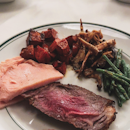
The restaurant only uses USDA Prime Grade Black Angus beef, all dry-aged on site in a proprietary designed aging room for 28 days.
Dry aging is known as a process where meat goes through a natural stage of tenderising itself to reach the perfect texture and flavour.
3 specific goals of dry-aging meat, all of which contribute toward improving its flavor or texture.
1) Moisture loss - A dry-aged piece of beef can lose up to around 30% of its initial volume due to water loss, which concentrates its flavor.
2) Tenderization occurs when enzymes naturally present in the meat act to break down some of the tougher muscle fibers and connective tissues.
3) Flavor change - caused by numerous processes, including enzymatic and bacterial action, along with the oxidation of fat and other fat-like molecules. Properly dry-aged meat will develop deeply beefy, nutty, and almost cheese-like aromas.
Steak was served in a hot plate where you could still hear the sizzling sounds when it was brought to the table. We were introduced that there were two cuts on each side of the T-bone – the Sirloin (right) and the Filet Mignon (left)